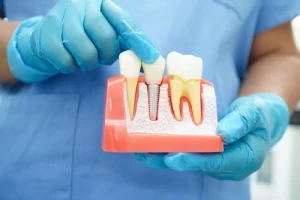A bone graft is frequently an essential step before getting dental implants, particularly if bone loss has occurred as a result of gum disease, missing teeth, or other oral health problems. While this procedure is highly successful, it’s also normal to experience certain side effects during recovery, one of the most common being swelling. Understanding why swelling happens, how long it lasts, and how to care for the surgical site can help you feel more comfortable and confident as you heal.
Why Bone Grafting Is Sometimes Needed
Before dental implant surgery, your dentist must ensure enough healthy jawbone to support the implant. If you’ve experienced bone loss, perhaps due to missing teeth, gum disease, or long-term denture use, a bone graft helps rebuild the area. This involves adding new bone or bone-like material to the jaw to integrate with your body’s tissue and create a strong foundation for the implant.
The grafting process encourages new bone to form and strengthen over time. While it’s a highly effective treatment, it also involves oral surgery, which naturally causes the body to respond with inflammation and swelling as part of the healing process.
Why Swelling Happens After a Bone Graft
 Swelling after dental implant bone graft is a normal reaction. It’s your body’s way of responding to surgical trauma and beginning the healing process. During surgery, tissues, blood vessels, and gum tissue are disturbed, triggering the body to send fluids and immune cells to the graft site. This leads to localised swelling, which helps protect the area and support healing.
Swelling after dental implant bone graft is a normal reaction. It’s your body’s way of responding to surgical trauma and beginning the healing process. During surgery, tissues, blood vessels, and gum tissue are disturbed, triggering the body to send fluids and immune cells to the graft site. This leads to localised swelling, which helps protect the area and support healing.
Here’s what you should know about swelling:
- Timing: Swelling often peaks 48 to 72 hours after surgery.
- Duration: Most swelling starts to subside after the first week, but can linger mildly for up to two weeks.
- Location: It usually appears near the surgical site, near the cheeks, gums, or jaw.
Mild bruising, tenderness, and discomfort are also common and should gradually improve as the bone graft heals.
What’s Considered Normal During Recovery
The recovery timeline can vary depending on the procedure’s complexity, the grafted area’s size, and your overall health. However, some general healing milestones can guide your expectations:
- First 24 hours: Mild bleeding and oozing may occur, and swelling begins.
- First week: Swelling peaks and then starts to reduce. You may feel discomfort, but prescribed antibiotics and medication usually help manage it.
- One to two weeks: Swelling should significantly decrease, and soft tissue healing improves.
- Several months: New bone gradually forms, creating a stable foundation for dental implants.
During this time, following postoperative instructions carefully is crucial. Maintaining good oral hygiene, staying away from smoking and alcohol, and following a nutritious diet all play an important role in ensuring a smooth recovery.
How to Reduce Swelling and Support Healing
There are several effective ways to minimise swelling and promote proper healing after a dental bone graft. Most of these involve simple home care strategies combined with following your dentist’s advice.
1. Use Ice Packs in the First 48 Hours
Applying ice packs to the outside of your cheek for 15-20 minutes at a time during the first 24 to 48 hours can significantly reduce swelling. Ice helps constrict blood vessels and limit fluid buildup at the surgical site.
2. Keep Your Head Elevated
When resting or sleeping, keep your head elevated with extra pillows. This helps reduce blood flow to the area, preventing increased swelling and discomfort.
3. Stick to Soft Foods
Eating soft foods for at least two weeks protects the graft site and prevents irritation. Hard foods can disrupt the blood clot or damage the healing tissue, increasing the risk of complications. Yoghurt, mashed potatoes, soups, and smoothies are ideal during this period.
4. Avoid Smoking and Alcohol
Using tobacco or drinking alcohol during recovery can delay healing, raise your risk of infection, and lower the chances of a successful bone graft. It’s best to avoid these entirely during your recovery.
5. Follow Prescribed Medications
If your dentist prescribes antibiotics or pain medication, take them as directed. Antibiotics help prevent infection, while pain relief can make recovery more comfortable.
6. Maintain Proper Oral Hygiene
To prevent infection, it’s important to keep the surgical site clean. Gently rinse with salt water as recommended, and avoid brushing directly over the grafted area until your dentist advises.
Signs That Something May Be Wrong
While swelling is a normal part of the healing process, certain symptoms can indicate complications that require prompt dental attention. Contact your dentist if you experience:
- Severe pain that doesn’t improve with medication
- Increased swelling after the first week
- Heavy bleeding that doesn’t stop
- Foul odour or discharge from the graft site
- Fever or chills indicate a possible infection
These signs could mean there’s a problem with the graft or healing process and should not be ignored.
What Can Influence How Well You Heal?
 Each person’s recovery is unique, and several factors can influence how quickly and smoothly your body heals after a bone graft:
Each person’s recovery is unique, and several factors can influence how quickly and smoothly your body heals after a bone graft:
- Medical conditions: Diabetes, immune disorders, and certain medications can slow healing.
- Lifestyle habits: Smoking and a poor diet increase the risk of complications.
- Oral hygiene: Keeping the area clean reduces the chance of infection and promotes faster healing.
- Extent of surgery: Larger grafts or procedures involving sinus cavities may take longer to heal.
Following your dentist’s post-operative care guidance and maintaining proper oral hygiene can greatly enhance the success of your treatment.
What to Expect as the Bone Graft Heals
The healing process continues well beyond the initial swelling phase. Over the following months, your body works to integrate the grafted bone with your existing jawbone. New bone begins to form, creating a strong and stable structure capable of supporting dental implants.
It’s a gradual process that requires patience, but once complete, it provides a secure foundation for your implants and long-term oral health.
Final Thoughts on Your Healing Journey
Swelling after dental implant bone graft is a natural part of the body’s healing response and usually not a cause for concern. With the right care, most patients recover smoothly and go on to enjoy successful dental implants that restore function and confidence. Following your dentist’s guidance, maintaining proper oral hygiene, and giving your body the rest it needs will help ensure a strong recovery and a healthier smile.
If you experience any unusual symptoms or have concerns about your healing process, don’t hesitate to reach out to your dentist. Early intervention can prevent complications and support the outcome of your dental treatment.
For personalised advice and expert care throughout your recovery, contact Beyond Infinity Dental at (02) 8806 3799 to book a consultation and discuss your treatment options.
Note: Any surgical or invasive procedure carries risks. Before proceeding, you should seek a second opinion from an appropriately qualified health practitioner.
References
- NHS. (n.d.). Take care of your teeth and gums. Retrieved from https://www.nhs.uk/live-well/healthy-teeth-and-gums/take-care-of-your-teeth-and-gums/
- Cleveland Clinic. (n.d.). Dental bone graft. Retrieved from https://my.clevelandclinic.org/health/treatments/21727-dental-bone-graft
- ScienceDirect. (n.d.). Dental bone grafting: A review of current techniques and materials. Retrieved from https://www.sciencedirect.com/science/article/pii/S0020653920326083









